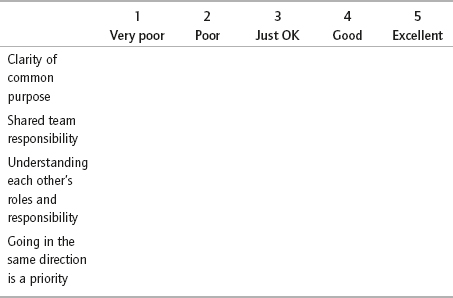chapter 10
How do you get everyone going in the same direction?
- Increasing understanding of the team’s common purpose
- Creating shared team ownership of goals
- Getting the team aligned towards a shared outcome
‘Vision without action is merely a dream. Action without vision just passes the time. Vision with action can change the world.’
Joel Barker
Self-assessment
Before reading the chapter, do the following quick self-assessment.
How would you rate the following in your team?
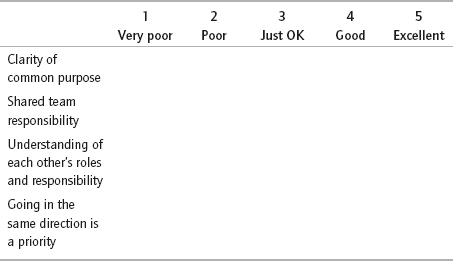
A team thrown together
It was time for another team re-organisation. Ted found himself reporting to a new manager again. It was his third in two years.
I don’t mind the new reporting line, Donald is not a bad leader, but it means I’m now forced into a team with Trevor! It really doesn’t make sense to me that we should now somehow work together. We have absolutely nothing in common. In fact, I don’t think he even comes close to understanding or representing what my team does, so it feels false, forced and uncomfortable. And now Donald wants us to have some kind of shared team event. I need to talk to him about all this; it just doesn’t make sense.
Ted’s thoughts were interrupted by Donald’s very timely entrance into his office.
‘Hi Ted. I’m glad I caught you. I need to check some possible dates with you for the planned team event.’
Ted looked down rather than meeting Donald’s gaze. ‘OK’ he muttered.
Unperturbed, Donald continued. ‘I want it to be 10 February. Does that work for you?’
‘Not sure I can make the tenth. February overall isn’t a good month for me.’
‘Well, it needs to be February. What date can you do?’
‘I don’t want to seem uncooperative, but I don’t actually see the point in a team event with Trevor’s team. The only thing we have in common is reporting into you. That doesn’t make us a team, not in my mind anyway.’ Ted paused.
Donald hadn’t even considered that there might be resistance to his plans of bringing together his direct reports.
‘What’s the problem? You do both report into me and that makes you part of my team. So the team event is going ahead. So can you please let me know what dates you can do in February?’
‘Well, I could maybe make the 12th work,’ Ted admitted. ‘But what are we going to do? What’s the point of this event?’
Donald was getting annoyed and snapped: ‘Oh come on, Ted. This is how it is. We have to be a team because you all report into me. Let’s just get on with it! This session will help us do that. We’ll all get to know each other better and that will be that.’ His tone indicated that the conversation was over.
When Donald had left, Ted was even more frustrated than he had been before their conversation.
I don’t want to be directly associated with Trevor. My team is very different to his. I’m struggling to see what we have in common.
Exploring the problem
Ted is clearly struggling to see any connection between his new peer and himself.
He understands that the organisational change has thrown them together but he doesn’t understand what makes them a team.
Donald thinks Ted and Trevor are a team because they report into him. This is not enough for Ted who feels more frustrated after their talk.
Feeling superior
Ted feels superior to Trevor and his team. He doesn’t think Trevor represents the same values or holds himself to the same high standards as Ted does. Therefore he worries that being associated with Trevor will negatively impact his image and reputation in the organisation. This makes him less cooperative than he would normally be.
No shared purpose
Ted can’t see what Trevor and he have in common, and therefore he rejects the idea of them being a team. There is no obvious shared purpose for them both, or their teams.
They are not working on the same things and they are not heading in the same direction.
When team members are not aware of a shared purpose, there will be no obvious reason to work together.
Donald needs Ted and Trevor to be a team, for his own practical purposes, but he is unable to give a convincing reason for this, or just hasn’t considered that he needs one.
The reasons for team members not going in the same direction
They don’t know where to go
If there is no common purpose and direction, people will do their own thing, focus on their specific tasks or do very little, as they’ll have no drive to go anywhere beyond just getting the job done.
There is a conflict of roles and responsibilities
If roles and responsibilities have been created more or less in isolation, any connections between the roles are unlikely to have been explored enough. This may, for example, be the case if two teams merge and the lines of responsibility are blurred. This could mean that either too many people are taking responsibility for a task, or no one is, both of which undermine any sense of going in the same direction.
Their goals are not aligned
If there are no team goals, people will only be working on their own individual goals, which may be in conflict with those of their team members. This further feeds the feeling of not going in the same direction and creates a downward spiral into non-collaboration.
They don’t understand their purpose
The purpose is either not known to them, or they don’t feel the emotional bond that’s needed to be able to truly understand it and act on it.
It’s not obvious that they need to go in the same direction
A leader may assume that team members understand they should collaborate towards an outcome, instead of pointing it out explicitly to them. Many leaders leave that assumption at an implicit level, especially if it’s clear to him/herself.
Team purpose and direction is not prioritised
Team purpose and direction is not discussed and hence not prioritised. Focus is given to the short term, the individual tasks in the here and now, rather than the team’s reason to be.
They don’t want to work together
There’s a resistance to collaboration due to personality differences, current conflicts, having worked together before unsuccessfully, not knowing each other, not liking each other, not trusting each other and many other reasons. Previous bad experiences, where people have encountered each other, shape their opinions of each other. This colours their perception into the future, even though the current reality could be very different and the person could be different in this new context.
The resistance can also be a reaction to not feeling involved or having a say in the matter.
The impact of teams not going in the same direction
- It’s demotivating and affects engagement levels. Team members then need to find other ways to be energised, which may turn them away from their work, and lead them to be distracted and to lose focus.
- It can create work/responsibility overlaps, extra work, duplication of work and inefficiencies. Unclear responsibilities mean that too much or too little is done.
- Team members may start making up their own purposes, which can be in conflict with those of other team members, driving them even further apart. People end up doing their own thing, being more influenced by self-interest than what’s best for the company. They work in isolation, focused on their own needs. The effect is they are not looking out for each other within the team or supporting each other outside of the team. This can be seen as disloyalty.
The impact on the business, customers, employees and stakeholders
When employees are not aligned and not going in the same direction, the rework and low engagement and even employee turnover becomes costly to the organisation. Duplication of work and effort has a high impact on the bottom line too.
Michelle was on a conference call with her colleagues. A number of them were located in another office and mainly communicated via email and conference calls. The calls were made up of long monologues on results, which meant very little to her and she had often, in her mind, questioned the relevance of the calls. She found herself distracted by the new camera features on her mobile phone and started taking pictures of the scenery outside the window. She suddenly heard her name called out and forced herself back into the call and started reading through her update. Within a minute or so one of her colleagues interrupted her and asked her why she was reporting on something that he had already covered. This was news to Michelle who had neither heard his update nor known that he was working on a similar initiative to her. She felt annoyed at herself for letting this happen. She was also feeling despondent about the time she had wasted doing the same work as someone else.
This example highlights two key issues. The team members are working in isolation, not knowing what the others are doing. They are also lacking a sense of shared direction and responsibility and therefore not taking a real interest in what is going on in the call.
When goals are not clearly connected, the leader will need to get involved, especially if goals are counterproductive to each other. This would not have been necessary if people within the team had been aware of their shared purpose and taken shared responsibility. It’s a waste of the leader’s time and it undermines the team’s self-esteem.
Let’s look at another example.
A service organisation had a high employee turnover for a few years. Through exit interviews they identified that most of those who were leaving had experienced a feeling of ‘no point’ to their job. They reported feeling as if it was all just about meeting the numbers. They hadn’t understood the bigger picture and the purpose of the organisation. This made the CEO painfully aware that they hadn’t done a good job at communicating that their reason to be was to create a worry-free situation for the customers. Had the employees known this they could have had a purpose to their job and made their role bigger than just delivering the numbers. They would have connected to it at an emotional level and given their own job more meaning.
As this example shows, people respond to purposes. If employees can’t see how they are contributing to something bigger than the task at hand, the job is often not as engaging and motivating as it could have been had the purpose been understood and bought into.
Solutions
Dr Martin Luther King famously said, ‘I have a dream …’. He didn’t say, ‘I have a strategic plan …’. Joking aside, he had a dream, a vision of a better future (he possibly had a strategic plan as well, but that wasn’t part of the communication message that became so famous). These two things are very different in nature and are appropriate and effective at different stages of progression. It’s rare for people to get passionate about strategic plans, that’s not their purpose, but dreams and visions can be compelling and engaging. Good visions have a few components in common. They are inspirational, they paint a believable and appealing picture of the future which people can feel, they engage both hearts and minds. Great visions help you experience what it will be like to get there; how it will feel, what it will look and sound like. They make people passionate and lead to actions that are practical.
It’s the leader’s role to rally people behind the compelling reason to be, the purpose, in order to achieve or at least aspire towards the vision. The vision gives meaning and purpose to what a team does.
To get the full power of a vision, you need awareness of the current reality too. If the vision is strong enough, it makes the team take the necessary actions to lead them there. The pull of the vision, when appealing enough, draws the team towards it. The natural tension between where you are as a team and where you want to go, is resolved.
This then helps in the creation of the strategic plan to move in the direction of the vision.

Figure 10.1 Current reality to vision
Research into human motivation, shows that purpose is one of the strongest factors for intrinsic motivation.6 Purpose answers the question ‘why’ and gives meaning to what we do.
By getting your team to march in the same direction, you overcome the challenge of a disparate team.
Let’s get specific on how to do it.
Solution 1: Create a vision
If there is no vision in place, you may want to create one. It’s not an absolute must for a team to have their own vision (the vision of the organisation can be enough). However, if you want to create a team one, here’s some food for thought.
A great vision is aspirational; you don’t necessarily need to achieve it, but you need to continue to experience its pull. You might even argue that you don’t want to achieve a vision, because then you would need to create a new one. Regardless, a vision is something that inspires you and moves you forward.
Here’s a vision creation exercise to help you:
Get a stack of magazines, scissors, glue, tape, post-it notes and a big flipchart. Have everyone go through the magazines and cut out any pictures or words that capture their attention as a representation of what the vision could be about. Ask them to simply focus on the future, what it will look, feel and sound like when you get to the vision. Stick the pictures onto the flipchart to make a collage. Ask each team member to explain why they have chosen the pictures and make the connections. As a team use this discussion to form the key words to create and describe the vision. Then, the team can wordsmith the vision using the key words from the discussions.
Here are some examples of potential team visions:
- To become the best service team in the industry
- To be the team where everyone wants to work
- To be the team that fully supports the organisation by helping each and every customer.
Solution 2: Identify the common purpose together
Closely linked to the vision is a team’s purpose. A team’s purpose is the reason to be, what they are here to do. Involve your team in identifying or clarifying the common purpose that you share. All teams have some shared purpose, the reason to be, that all team members need to both understand and buy into. By involving the team, rather than just telling them what it is, everyone becomes an owner of the purpose. The process can be fast-forwarded by having input from the team on what they think the purpose is through a climate study. A climate study is a simple process, that can look like this:
- Step 1: You interview each person.
- Step 2: You gather all of the interview notes and everyone’s individual thoughts on the team and the purpose.
- Step 3: At the meeting you discuss the purpose and the outcomes of the Team Climate Study. As they already have a lot of input from the study, it helps them hit the ground running.
Solution 3: Make the purpose grounded
The purpose needs to be clear to all, actionable and tangible. It needs to be something that can be achieved. Making the purpose grounded is about creating the team map, explaining that ‘because we do this, we are able to achieve what we are here to do, and we contribute directly to the vision and purpose of the organisation as a whole’. The team map makes the links for everyone and is a way of creating an overview for the team.
Solution 4: Clarify roles and responsibilities
Having clear roles and responsibilities for all team members makes the purpose even easier to take personal responsibility for. Here’s an exercise you can do to make everyone aware of your individual responsibilities in the team:
Part 1: Take turns writing down your role and responsibility and ask others to write down what they think your role and responsibility is – and then check: is there a mismatch? If so, this may be another reason why you are not achieving alignment as a team.
Part 2: identify what people like doing – and re-allocate responsibilities based on that or put into place ‘buddy systems’ to allow people to share and teach others to do the things they themselves like doing. We are more likely to enjoy and do an excellent job on things we enjoy doing.
Solution 5: Create shared team responsibility
Individual responsibility is key, but so is shared responsibility. Discuss as a team what your shared responsibilities are – ultimately it’s fulfilling your purpose. Each person needs to understand that he/she is responsible for the overall results of the team, not just their individual goals. One way of doing this is to make sure that all goals are aligned in some way, so that it’s not even possible for someone to go for individual success without considering the rest of the team.
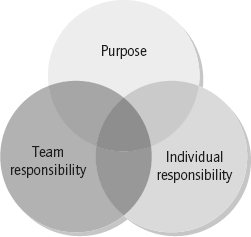
Figure 10.2 Shared team responsibility
Solution 6: Create a link
Even if there is a tenuous link between what team members do, like in the story of Ted and Trevor, you can create that link and make it stronger. You can actively look for what people have in common through their contribution to the organisation and the benefits they can have from being a team, thereby giving them a shared purpose.
Solution 7: Use a crisis to show you the way
During a crisis, team members are forced to work together to solve the issue. If your team experiences a crisis (e.g. a system breakdown, bad press, big customer issue), then use the learning that crisis gives. Look at how you did it, what worked and what didn’t. Identify how you need to work together, how you can be better aligned for successful results. Don’t wait for another crisis to work together – work together like that every day.
Solution 8: Give strengths-based feedback
Be observant and recognise how each person contributes to the team’s work. Look for strengths in others and give them that feedback. Strengths-based feedback is when you share a specific observation you have made when a person’s strength was used AND clearly contributed to fulfilling the team’s purpose. The more information you can give, the more helpful it will be. It could sound something like this:
‘I have noticed several times that you are very good at piecing information together, making sense of seemingly disparate bits of data. And the way you did it today was particularly good. In our meeting, you proactively offered to share what you saw and were able to explain it in such a way that we could all see it too. As a result, we quickly got a shared view of a new perspective on how to solve the issue with the new customer requirements. It was great – please keep doing it!’
Telling people about their strengths, rather than telling them what they have done wrong, reinforces those strengths and helps them to use the strengths more. When hearing about their strengths, people connect with them as part of their own purpose which can then connect to the team purpose too.
Solution 9: Create a team charter
A team charter is a document that describes the purpose, framework and agreements of the team – many of the solutions listed above. The team creates it themselves, hence making it a powerful and a visual shared commitment. It typically at least includes:
- Purpose and clear links to organisation’s vision and purpose
- Expectations and goals
- Roles and responsibilities
- Skills and expertise needed (to fulfil purpose)
- Resources needed (to fulfil purpose)
- Operating guidelines: behaviours and how the team will work together (to fulfil purpose)
- Signed agreement.
Let’s have a look at what Ted and Donald could have done instead, had they deployed these solutions.
Donald was thinking hard. In the latest re-organisation he had been asked to take on two senior leaders who had previously not worked together and on the surface of it didn’t seem like they had much in common. But somehow he needed to make it work.
Now that I think about it though, there are some great opportunities in them being on my team. Ted’s international experience paired with Trevor’s knowledge of the customer could help us look at our client communication in a new creative way. I will sit them both down and explain how both their teams contribute to the overall client experience and ask for their input. I think we can break new ground here.
He picked up the phone and called Ted first.
‘Hi Ted. I’m glad I caught you. I have some interesting ideas that I would like to share with you. The change in reporting line, which I know has initially resulted in some raised eyebrows, is showing some great new opportunities for us that I think you will like. Can we meet and talk?’
Ted’s interest was piqued. ‘Absolutely – do you have any time today? Let’s get together.’
Behaviours of team and leader
Under ‘Solutions’ above, we have listed a number of ‘how to’ actions. These solutions work best when carried out with these supporting ‘how to’ behaviours. The actions on their own, will get you only so far.
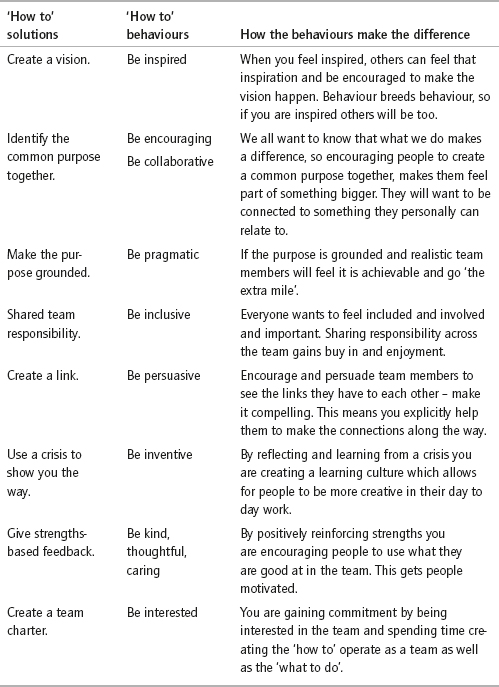
Thoughts and feelings of team and leader
On average, a person experiences around 70.000 thoughts per day.1 Many of those thoughts are habits that affect a person’s mindset or outlook.
What we think affects how we feel, and how we feel affects how we think.
When wanting a team to go in the same direction, together, actively replace thoughts and feelings that are counterproductive to that. Here are thoughts from the story, their impact on feelings and how they can be changed.
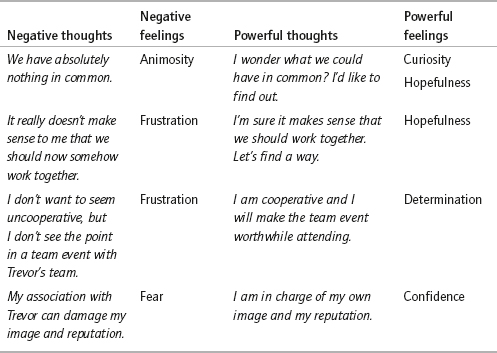
Summary
Reason to be
For a team to walk in the same direction, they need to know where they are going or contributing to (vision) and why (purpose). This kind of clarity provides the framework and ‘reason to be’ that can really rally a team to work together towards goals that fulfil their purpose.
Remember that visions need to be compelling and purposes meaningful. People respond to the importance in both of these and the sense of making a difference to someone or something. A great example of this is the janitor at NASA who expressed that his job was to put people in space. He was able to see how important his job was in contributing to something that he thought was important and he could rally behind.
Time to focus on purpose
Time needs to be spent on this as early as possible in a team’s existence. It also needs to be reviewed and recommitted to at regular intervals, when goals are set or adjusted, and when new team members join. A clear vision and joint purpose also provides a great framework for new employees, which can enable them to more quickly see the meaning in their job and how they can contribute.
Reflection questions for the reader
- Would my team benefit from having a specific team vision?
- Do we all know what our team’s purpose is?
- How do we need to work to best achieve our purpose?
- What crisis have we been through that we could learn from?
- How clear are the shared team responsibilities?
Self-assessment
After you have implemented the solutions in this chapter, answer these questions again to see the progress you have made.
How would you rate the following in your team?
‘If you want to build a ship, don’t drum up people together to collect wood and don’t assign them tasks and work, but rather teach them to long for the endless immensity of the sea.’
Antoine de Saint-Exupery

